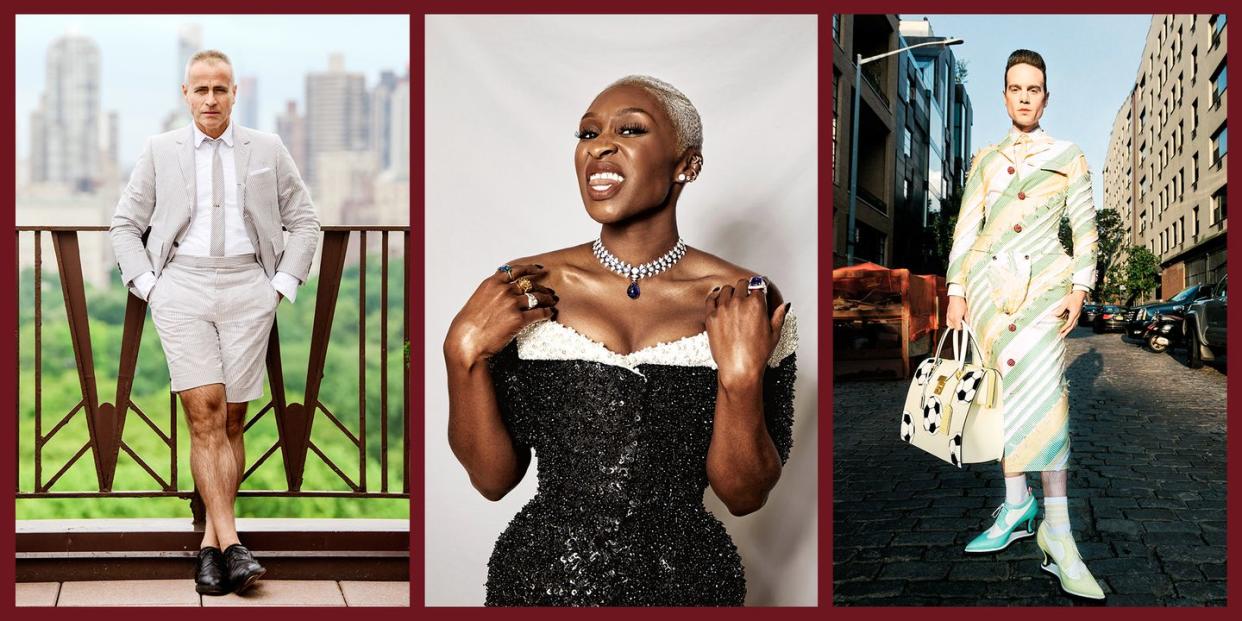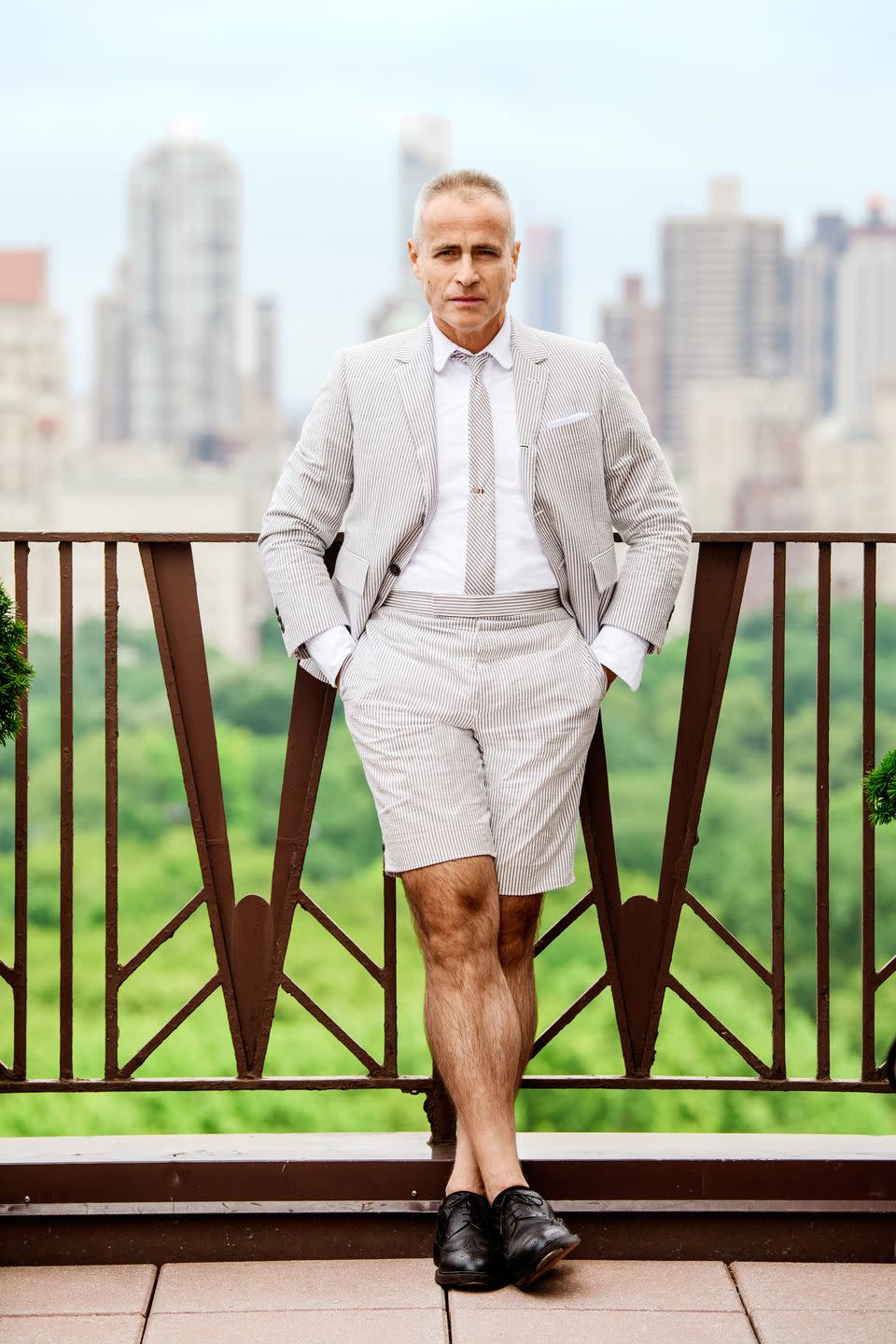Thom Browne, Cynthia Erivo, and Jordan Roth In Conversation: Vive La Différence!

Some clothes speak a secret language. Pieces made by the New York designer Thom Browne can look like uniforms (Browne is famous for snug suits, sometimes with short pants, which he himself wears religiously) or cutting-edge takes on red carpet glamour (recall, if you will, Cardi B’s red feathered ensemble at the 2019 Met Gala), but they all offer a message about originality, character, and gusto that can be deciphered only by the members of a very exclusive club. This month Browne’s designs will be transmitted digitally, as a virtual presentation replaces the traditional Paris Fashion Week extravaganza.
It’s no wonder, then, that Browne has found kindred spirits in the powerhouse theater producer Jordan Roth and the Tony-winning actress Cynthia Erivo (pictured above). Both are as daring in their fashion choices as they are in their work (he has produced such hits as Moulin Rouge! and Hadestown; she is playing Aretha Franklin in the upcoming TV series Genius), and both have formed a bond with Browne that goes beyond the average designer-client relationship.
Think of it as an open-ended collaborative process, or perhaps a laboratory for three very well-dressed mad scientists; either way, this trio has created a space where creativity, eccentricity, and originality are as essential to fashion design as needle and thread.
What does it mean to truly collaborate, and how did Browne, Roth, and Erivo learn to speak a lingua franca? Town & Country gathered the three to talk about their work together—how it happens, what it means, and why working together makes each of them feel invincible.

Thom Browne: I think the first question is, what is Jordan wearing? Because everybody knows what I’m wearing…
Jordan Roth: Are you still wearing what I think you’re wearing?
TB: Yes.
JR: I could not love you more.
TB: How disappointing would it be for everyone if I answered that I was in sweats or a T-shirt? I would be disappointed in myself.
JR: I have been in the same Celine sweater and jeans for, I don’t know, three months.
Cynthia Erivo: Thom, I’ve always loved the individuality of your pieces. The first time we worked together was for the 2017 Met Gala, when I wore your pearl motif. It was the second year I was invited to the Met, and you made the dress of all my dreams.
TB: I loved that dress.
CE: It was just wonderful. I still remember the deconstruction of the suit, the jacket that was at my hips and made the bustle, and the pearls all over it. It was so beautiful. I loved the individuality in your pieces and the way it didn’t really matter what gender you were—you could still wear everything. It’s the wonderful way that you’re able to express all sides of someone, and that’s what drew me to you in the first place.
TB: I knew of Cynthia because of how talented she is; it’s her talent that really grounds her importance. But also she’s somebody who has such a sense of herself. I think there are so many people out there that just get dressed by other people, but working with her was so special because I was with somebody who knew what she liked, knew what works for her, knew what was interesting, and also appreciated true design. She wasn’t just wanting the latest trend.
CE: Here’s the thing: I can’t be that person if the designer is not honest or is afraid. I can’t be all I want to be if, say for instance, you weren’t welcoming. Because you were, we could have fun. I remember when we were working on designing that dress that we both had an understanding that it wasn’t just a dress, it was art.

JR: I’ve loved Thom’s work forever. We had this sort of extraordinary first experience at a dinner that Thom hosted. Thom sent over this piece that was instantaneously everything that had ever been in my mind and my body, made out of fabric. Was it a coat? Was it a dress? Yes. It was both. I put this piece on and went to dinner, where I was seated next to Thom. We just kind of dove in together, and I’ve been in love ever since.
CE: Jordan, there’s a balance between masculine and feminine, which I think is a place I live in as well. Thom has found that in each one of us and said, “You’re allowed to enjoy both of these things.”
TB: When I design, I really don’t think about masculine or feminine. I think more about what a true individual would be interested in being. And I don’t want to waste their time in showing them something that they’ve seen before! Of course, I want my clothes to be worn by somebody, but when you’re starting a conversation you don’t want to bore someone by doing something banal. There are always questions after my shows, like who would wear that?
JR: I always raise my hand when those questions are asked.
TB: That’s why these relationships have become so special. It’s being able to know that there are those people who really do want me to stretch my ideas, who really want me to design and not just make clothing.
JR: That’s what’s so compelling about wearing your work. Yes, it’s beautiful, but it’s also about an idea.
CE: There isn’t a day that I wear your clothes when no one asks me about them. It’s more than an outfit, it’s a concept waiting to be cracked open, and people can’t resist asking about it.
TB: It’s important for me to create things that transcend fashion but are grounded in some very understandable ideas. That’s one of the reasons sports are always an interesting reference for me, because there’s something about sports that’s very democratic; everyone’s somewhat familiar.
JR: I am familiar with sports, but I don’t totally understand them.
TB: Well, you’ve carried a soccer ball bag.
JR: You’re helping me.
TB: What’s most important for me is that the art of creation transcends fashion. Even with the way that we represent ourselves in the office, the gray suits [the staff wears] are so much more than a uniform. It’s not as though I’m insisting that everybody wear a gray suit. I want them to be in a world that is so much more interesting than fashion.
CE: It’s my favorite thing about coming to the office, because nobody is wearing it the same way. It feels like, because of the person wearing it, because of how they put it on, each piece is totally different.
JR: That’s why I feel like Thom is able to help us focus on ourselves as individuals from two very different points of entry. Everybody’s uniqueness is exposed in such a beautiful way in the same piece. Or from the other direction, singular, one-of-a-kind pieces of art for one-of-a-kind moments help us excavate and celebrate an individual.
TB: It’s a total gift, because it always works for true individuals. When somebody is so confidently true to themselves, that’s what’s most inspiring to me. And it’s so rare.
CE: I’ve had many experiences when a designer has a specific idea in mind, and there is no space to find what feels right for me. The excitement for me when I’m walking into your office is that it does feel like playtime. There’s a real give and take—should we do this?—and I love that.
JR: Cynthia, your work is so singularly and gloriously from you and only you. And that’s part of how I think of your transcending fashion: You’re never lost in your selections. We always see the through line that is you as an individual.
CE: I ask to be made more uncomfortable in the pieces consistently. I’m like, “If you want to put a good old corset in there, go for the gold and make sure that corset makes me not breathe.” Because I trust Thom, I always ask for more. I want to be challenged.
JR: I’ve turned to Thom in moments when I was already uncomfortable. For instance, this past holiday season I was invited to a dinner, and after I accepted I found out that it was at a club that required a jacket and tie for men, which sort of put me in a tailspin. I don’t wear a jacket and tie. That’s not who I am. And then I realized, Oh, wait. I do wear jacket and tie—but only Thom Browne, because that jacket and tie on me may not be just a jacket and tie. It may be a jacket and tie and a skirt and a heel and a bag, and it is the totality of me. And so that’s exactly what I did. And they all loved it.
CE: Of course they did. People don’t know if they love something until you give it to them.
TB: The most important thing is that it’s not forced. For both of you, we see the individuality in the things that you’re wearing; we see the person more than the clothing. We see the confidence that you exude in being exactly who you are.
JR: It’s an outward expression, but it is also an inward expression—and that confidence comes from the inward expression. It comes from living our evidence. I will tell you, it’s true for me whether I’m in one of those really extraordinary pieces or whether I throw on my favorite cardigan. Each of those carries that power.
This story appears in the September 2020 issue of Town & Country. Subscribe Now
You Might Also Like


